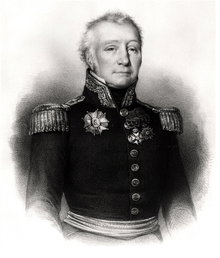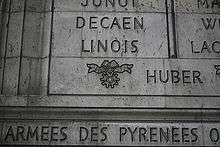Charles-Alexandre Léon Durand Linois
| Charles-Alexandre Léon Durand Linois | |
|---|---|
 Portrait of Linois, by Antoine Maurin | |
| Born |
27 January 1761 Brest |
| Died |
2 December 1848 (aged 87) Versailles |
| Allegiance |
|
| Service/branch |
|
| Rank | Admiral |
| Battles/wars | |
Charles-Alexandre Léon Durand, Comte de Linois (27 January 1761 – 2 December 1848) was a French admiral during the time of Napoleon Bonaparte. He won a victory over the British at the Battle of Algeciras in 1801[1] and led an unsuccessful campaign against British trade in the Indian Ocean and South China Sea in 1803.[2][3]
Biography
Born in Brest, Linois joined the French Navy as a volunteer in 1776, when he was 15 years old.[1] He was promoted to lieutenant in 1791 after participating in the American War of Independence.[1] From 1791 to 1793 he was posted to Isle de France (now Mauritius) where he served in the French forces in the Indian Ocean.[1]
After his return to France in 1794, he was based in Brest. Linois was captured by the Royal Navy at the Action of 7 May 1794 while his ship was protecting a convoy of wheat from the United States. He was exchanged and promoted to captain, taking command of the 74-gun Formidable. The following year he was captured again at the battle of Groix, where he was twice wounded and lost an eye; he was again exchanged. In 1796 he took part in the Expédition d'Irlande as a chief of division, leading a 3-ship of the line and 4-frigate squadron, with his flag on Nestor. Arrived in Bantry Bay, the generals opposed a landing, and the squadron headed back to Brest, taking three prizes on the way.
On 12 April 1796 he was captain of Unité when HMS Révolutionnaire captured her. Revolutionnaire had no casualties because the French had fired high, aiming for her rigging; the British fired into their quarry with the result that Unité suffered nine men killed and 11 wounded.[4]
In 1799 Linois was promoted to Rear-Admiral (contre-amiral) and sent to the Mediterranean under Admiral Bruix. As second in command of the squadron under Admiral Ganteaume, he attacked Elba in 1801. Then in command of a small squadron based in Cadiz, he fought a larger British squadron under Sir James Saumarez in the Battle of Algeciras. His squadron prevailed during the first part of the battle, capturing HMS Hannibal, but on the return to Cadiz, two Spanish ships who had joined him were fooled into firing on each other by a British night attack and were lost.
In 1803 Napoleon Bonaparte appointed him to command the French forces in the Indian Ocean and, flying his flag aboard the 74-gun-ship Marengo, he harried British merchant ships across the ocean and into the China Seas. At the Battle of Pulo Aura in 1804, a squadron of French naval ships commanded by Linois encountered the British China Fleet of lightly armed merchant ships. The British ships outnumbered Linois' forces, manoeuvred as though preparing to defend themselves, and some flew naval ensigns. The tactics of the convoy commodore Nathaniel Dance fooled Linois into believing that the British fleet was defended by naval escorts and he retired without attacking the virtually defenceless British.
During his squadron's return to France, Linois encountered a large British squadron under Admiral Warren off Cape Verde. In their engagement, known as the Action of 13 March 1806, Linois was wounded and captured again. Napoleon had ended the practice of exchanging officers and Linois remained a prisoner of war until Napoleon fell in 1814. In 1810, while held by the British, Linois was named comte de Linois by Napoleon.
Following the Bourbon restoration, Louis XVIII named him to be Governor of Guadeloupe but as Linois supported Napoleon during the Hundred Days he was forced to resign after the battle of Waterloo. He was court martialled but acquitted in 1816. However, he was placed in retirement and never served again, although he was appointed as an honorary Vice-Admiral (vice-amiral) in 1825. He lived in Versailles, where he died in 1848.
Honours

His name is inscribed on the Arc de Triomphe.
In fiction
Linois is a minor, but highly respected, character in the Aubrey–Maturin series by Patrick O'Brian. Frederick Marryat describes the Battle of Pulo Aura in his 1832 novel Newton Forster, or The Merchant Service.
References
- 1 2 3 4 Piat, Denis (2010). Mauritius on the Spice Route, 1598-1810. Editions Didier Millet. pp. 195–196. ISBN 9814260312.
- ↑ The Campaign of Trafalgar, Gardiner, p. 19
- ↑ The Campaign of Trafalgar, Gardiner, p. 26
- ↑ The London Gazette: no. 13887. pp. 387–388. 26 April 1796.
External links
- Admiral Linois National Library of Australia, Newspaper Digitisation Project.
|